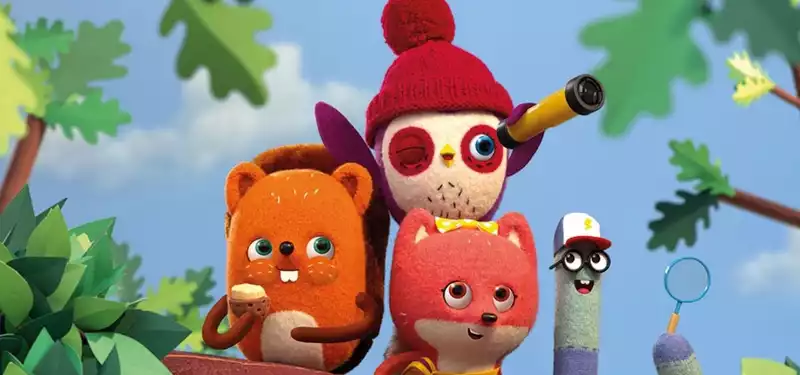Jul 31, 2019
How did "Becca's Bunch" achieve its unique blend of puppetry and animation?
In 2012, Chris Dicker saw an unusual short film at an Irish film festival, Fear of Flying, a playful and eerie tale featuring a bird that can't stand to fly. Producer Conor Finnegan shot live-action puppets, over which his team layered 2D and 3D animation. The result is a richly tactile and highly expressive visual world.
Dicker showed "Fear of Flying" to the team at Jam Media, a studio specializing in animation for young people for which he is head of development. With Finnegan's involvement, Dublin and Belfast-based Jam began developing a series for young children inspired by the film's approach. The premise of the story was modified to suit the audience. The creepy protagonist of Fear of Flying was replaced by Becca, an energetic young bird who is not afraid of many things, and Becca was given a new animal friend. Called Becca's Bunch, the series will follow the team's adventures in the Wagtail Forest.
After years of development, Nick Jr. came on board and commissioned 52 11-minute episodes. Jam was to replicate the production of Fear of Flying on a much larger scale. He contracted Factory Studios in Manchester to build the sets and puppets and shoot the live-action sequences. The edited footage was sent to Jam, who added animation and VFX (such as character limbs and facial features), then combined the whole thing into the finished product. Niall Mooney, who oversaw post-production, is unaware of any other children's series that has attempted such a hybrid approach.
"Becca's Bunch" premiered in the UK in July 2018 and launched in the US last September. Finnegan and Mooney spoke to Cartoon Brew about the various stages of the series' unusual filmmaking.
Conor Finnegan The dolls are all handmade and sewn together. The torso has a styrofoam core, which is covered with felted wool. The wool is all spun on traditional yarn spinning machines and washed in varying degrees to achieve the right amount of feltiness. The original dolls were made by Jessica Dance, a wonderful artist who works almost exclusively with wool. The props (4,000 in all) and sets are made from a variety of materials, but again, almost everything is handmade. Quite a bit of paper crafting was used for the grass, flowers, leaves, and bushes. I wanted to keep the style and graphics very simple and tactile.
Conor Finnegan We designed a puppet rig consisting of sticks and oval wheels; we had made something similar (but more lo-fi) for Fear of Flying. The elliptical wheels gave the puppet an up-and-down pulsating motion, much like a walking cycle. The rig also had a small dial that allowed the doll to rotate and swivel. Some sets had removable bases that allowed the puppeteer to get under the puppet (under the set) and manipulate it in a more traditional way.
Conor Finnegan I think the hybrid look and feel of Fear of Flying was part of the selling point of the show. We decided to shoot on camera whenever possible. By using that as a guideline, we were able to make decisions more quickly on set. Some scenes had to be shot in multiple passes. For example, in a crowd scene, we would shoot four puppets at once and mark their positions so that the characters would not overlap each other. Then, offline, they are combined into one scene.
I have done some amazing things with camera work, such as action scenes where characters run on rolling logs, scenes set underwater, and scenes shot on ultra-miniature sets to fake scale. I directed the live-action photography and wrote the director's notes for all 52 episodes, shot by shot. The entire shoot lasted 192 days.
Neil Mooney Since there were five different versions of each puppet, all handmade and slightly different from one another, object tracking the puppets' movements pixel-perfectly was a major challenge. Initially, we tried to use standard 3D models of the characters based on the character designs used to create the puppets, but found that the tracking software was not accurate enough
.
We then considered scanning each doll in 3D, but this proved to be very costly due to the large number of characters and versions of each doll. Instead, detailed photographs of each doll were taken and photogrammetry (using a program called Realitycapture) was used to create an exact replica. This technique, coupled with the PF Track software, was a game changer. It provided the detailed model we needed very quickly and the tracking results were pixel perfect.
Neil Mooney Once the rods and wires were removed, the first problem arose. We shot blank plates of each scene without the puppets in place. This allowed us to remove the rods and wires very quickly. Cleaning up where the rods crossed behind the puppets required manual rotoscoping, and the fur textures also required very detailed rotos and cleanup. There was no single solution, as cleanup depended on the shot and the character.
Neil Mooney Modeling and rigging was done in Maya. Character animation was also done in Maya; fur, texturing, and lighting was done in Vray; CGI/fluid effects were done in Maya, Phoenix FD, and Houdini; all 2D animation was done in Adobe Animate, with final compositing done in Adobe After Effect. final compositing was done in Adobe After Effects and Nuke.
Matching the lighting on site and perfectly integrating the CG elements with the miniature sets and puppets was very time consuming and required a lot of R&D. Differences in textures, shadows, and lighting were immediately noticeable and required the creation of higher quality renderings.
.



Post your comment